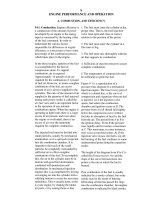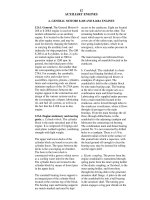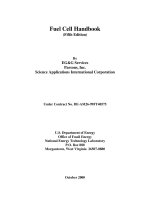Tài liệu Ethernet over VDSL docx
Bạn đang xem bản rút gọn của tài liệu. Xem và tải ngay bản đầy đủ của tài liệu tại đây (347.75 KB, 8 trang )
Ethernet over VDSL
White Pape
r
1. Introduction
VDSL (Very high data rate Digital Subscriber Line) is a broadband transport technology for
twisted copper pairs operating at data rates of up to 52.8 Mbit/s with corresponding maximum
reach ranging from 1000 feet (300 meters) to 4500 feet (1500 meters) of 24 gauge wire. VDSL
offers tremendous promise as a means to provide the next generation of high-speed networking
technology over copper telephone lines.
VDSL is referred to as a last-mile technology, as it is used for inter-connections between a
telephone switching station and a home or office, and is not used for interconnecting switching
stations.
2. VDSL Benefits
• Highest-rate DSL technology available
• Support for Symmetric and Asymmetric modes of operation
• Up to 52 Mbit/s downstream over single copper twisted-pair loop
• Coexistence with Voice
• Home networking or LAN over regular telephone lines
• The dominant physical access medium based on copper loop for MTU (Multi Tenant Unit) and
residential applications
3. VDSL Applications
• Digital Video broadcast
• Video-on-demand
• Video conferencing and Voice over IP
• LAN to LAN connection over the existing telephone wires
4. VDSL Deployment Scenarios
• Possible deployment scenarios for VDSL are Fiber to the Exchange (FTTEX), Fiber to the
Neighborhood (FTTN), Fiber to the Cabinet (FTTCab) and Fiber to the Building (FTTB). In FTTEX,
all subscribers are within close range of the Central Office (CO). FTTN and FTTCab are appropriate
for VDSL termination in DLCs and NGDLCs. FTTB can bring fiber directly into buildings, such as
MDU and MTU, where VDSL is terminated.
July 04 •
Ethernet over VDSL
Figure 1. VDSL Deployment Scenario
As demonstrated in Figure 1, VDSL technology enables transmission of high-speed
traffic between the Network, the ONU, and end user premises over the existing
telephone lines.
The VDSL CPE on the user side is connected to VDSL ONU over a twisted copper pair.
The connection of the the user’s home network to the public network is smoothly
achieved by a native Ethernet interface between the VDSL CPE interface and the LAN
on the user’s side.
5. Ethernet Over VDSL Technology
Using Ethernet Over VDSL technology enables the existing public copper network and
the user LAN networks to be used for migration to new emerging services. It also has
the following advantages:
• No need for new wiring
• Meeting consumer price and performance needs
• Cost effective high speed access - up to 20 Mbit/s or more
• Simple, easy to install; true plug-and-play
• Near-zero configuration
• Enables simultaneous delivery of additional services such as voice Ethernet
framing ensures compatibility with existing Ethernet LAN
• MAN/WAN compatible
• Eliminates protocol conversions
Figure 2 describes the components involved in the connection between user premises
equipment and the Ethernet core.
July 04 •
Ethernet over VDSL
Figure 2. VDSL Deployment Scenario
In Figure 2, the traffic from the user equipment to the CPE is transmitted over LAN
media using a native Ethernet frame.
The Ethernet frame is transmitted from the CPE to the IMAP or DSLAM over VDSL
using a twisted copper pair. The connection between the IMAP or DSLAM and the
Ethernet core can be applied over any transmission media, and the Ethernet frame
can be mapped to any destination over the public network using standard layer 2
MAC algorithms.
6. Ethernet over VDSL (EoVDSL) Frame Encapsulation
6.1 VDSL Frame Format
The Ethernet frame is encapsulated in the following VDSL frame format:
July 04 •
Ethernet over VDSL
Figure 3. VDSL Ethernet Frame
The payload is divided into two equal parts: fast channel for latency sensitive services, and slow
channel (mandatory). The slow and fast channel alternate as shown in Figure 3.
To apply the mandatory Transport Class 1 (single latency) the values F=0, S=200 should be set
to remove the fast channel fields from the transmitted frame.
6.1.1. Fast Channel
Figure 4. Fast Channel
Fast channel is optional, and defined for latency-sensitivity applications such as
Voice. The Fast Codeword should be <= 180 octets.
The number of Fast FEC octets can get the values 2,4,16 octets.
6.1.2. Slow Channel
July 04 •
Ethernet over VDSL
Figure 5. Slow Channel
The Slow channel is mandatory and defined for data transmission.
The Slow codeword consists of 3-octet Operation Channel (OC) field, a Slow Payload
field and a slow FEC field of 16 octets. The length of the Slow Codeword is ≤ 200
octets.
The slow codewords are protected by an Interleaver before transmission into the
lines; it carries both payload and in-band control channel.
6.1.2.1 Operational Channel
Figure 6. Operational Channel
The Operational Channel contains 3 octets per frame: one Op-code octet and two
data octets. It is used as transport media for VOC (VDSL Overhead Control) and EOC
(Embedded Operation Channel), while VOC used for control of the modem layers
(VDSL chipset), and EOC is used for management applications.
6.2 Ethernet Frame
July 04 •
Ethernet over VDSL
Figure 7. Ethernet Frame
• The Ethernet frame must be transferred transparently, without manipulating the
frame content.
• The encapsulation method is a store & forward mechanism. It is not data
dependant (no bit stuffing)
• EoVDSL is a PHY.
• Prioritization is performed by higher layer devices and packets are transferred in
the order they are received.
• The Ethernet packet is preceded by an IPG of 9.6 usec/0.96 usec for
10/100Mbit/s links.
• The preamble (0x55) is not used by MAC. The SFD (0x5D) is required by the MAC
layer.
The Data in Figure 7 refers to the Ethernet frame from the destination address to the FCS,
Destination Address, Source Address ,Type/ Length, DATA, FCS.
6.3 EoVDSL Encapsulation
July 04 •
Ethernet over VDSL
Figure 8. EoVDSL Encapsulation
The Ethernet frame (without preamble, SFD and EFD {Ethernet frame data}) is
encapsulated by a new preamble. Idle bytes are filled with flags.
• The preamble includes a length field.
• Ethernet Frame Data from destination address to FCS.
7. Conclusion
Ethernet over VDSL is an excellent solution for high speed applications. The media is highly
available, and cheap compared to other solutions. It is also simple to connect to, from any type of
equipment supporting Ethernet LAN, and no protocol conversion is required.
Teledata Networks Website: www.teledata-networks.com
Specifications published here are current as of the date of publication of this document. Teledata Networks
reserves the right to change specifications without prior notice. The information contained herein is Teledata
Networks proprietary information. Products or features contained herein may be covered by patents in one or
more countries. Copyright © 2004 Teledata Networks. All rights reserved. P/N 760-000544 Rev A. Original.
File Name: Ethernet over VDSL WP.doc









